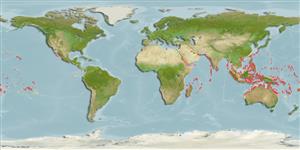Common names from other countries
>
Ovalentaria/misc (Various families in series Ovalentaria) >
Pomacentridae (Damselfishes) > Microspathodontinae
Etymology: Stegastes: Greek, stegastos, -e, -on = covered (Ref. 45335).
More on author: Lacepède.
Environment: milieu / climate zone / depth range / distribution range
Ökologie
seewasser riff-verbunden; standorttreu; tiefenbereich 1 - 12 m (Ref. 7247). Tropical; 30°N - 30°S
Indo-Pacific: Red Sea and East Africa to the Line, Marquesas, and Tuamoto islands, north to the Ryukyu and Bonin islands, south to New Caledonia and Tonga; throughout Micronesia. Excluding the Hawaiian Islands (Ref. 7247). Hawaiian population refers to Stegastes marginatus (Ref. 86689).
Size / Gewicht / Alter
Maturity: Lm ? range ? - ? cm
Max length : 14.0 cm TL Männchen/unbestimmt; (Ref. 4391); common length : 9.0 cm TL Männchen/unbestimmt; (Ref. 5450)
Rückenflossenstacheln (insgesamt) : 12; Rückenflossenweichstrahlen (insgesamt) : 15 - 17; Afterflossenstacheln: 2; Afterflossenweichstrahlen: 12 - 14. Diagnosis: Adults generally brown; dorsal part of head and nape darker, grading to tan on lower part of head and breast. The scales have darker brown margins. The lips are whitish lips; the suborbital is mostly blue; the preopercle and opercle scales with blue centers. The median and pelvic fins are brown; the pectorals are dusky; a well-defined dark brown or blackish spot is sometimes present at base of posteriormost dorsal rays, which distinguishes it from S. lividus where the spot is diffuse. Males in courtship or guarding eggs with broad white bar across middle of body and pale blue stripe from mouth to upper part of pectoral fin (Ref. 510).
Adults inhabit reef flats and lagoon reefs. Frequently occur in colonies associated with live or dead branching staghorn coral (Acropora). Feed on algae, gastropods, sponges, and copepods. Territorial, maintain and 'weed' filamentous algae patches growing on dead coral (Ref. 9710). They attack human intruders without hesitation, sometimes taking painful nips. Particularly aggressive during reproductive periods. The species emit clicking noises during aggressive encounters. Oviparous, males tend the nest visited by several females (Ref. 59295).
Life cycle and mating behavior
Maturities | Fortpflanzung | Spawnings | Egg(s) | Fecundities | Larven
Oviparous, distinct pairing during breeding (Ref. 205). Eggs are demersal and adhere to the substrate (Ref. 205). Males guard and aerate the eggs (Ref. 205).
Allen, G.R. and A.R. Emery, 1985. A review of the Pomacentrid fishes of the genus Stegastes from the Indo-Pacific, with descriptions of two new species. Indo-Pac. Fish. (3):31. (Ref. 510)
IUCN Rote Liste Status (Ref. 130435)
CITES (Ref. 128078)
Not Evaluated
Nutzung durch Menschen
Fischereien: weniger kommerziell; Aquarium: Öffentliche Aquarien
Tools
Zusatzinformationen
Download XML
Internet Quellen
Estimates based on models
Preferred temperature (Ref.
115969): 25 - 29.3, mean 28.4 (based on 3006 cells).
Phylogenetic diversity index (Ref.
82804): PD
50 = 0.5000 [Uniqueness, from 0.5 = low to 2.0 = high].
Bayesian length-weight: a=0.02399 (0.01480 - 0.03888), b=3.02 (2.88 - 3.16), in cm Total Length, based on LWR estimates for this species & Genus-body shape (Ref.
93245).
Trophic level (Ref.
69278): 2.2 ±0.0 se; based on diet studies.
Widerstandsfähigkeit (Ref.
120179): hoch, Verdopplung der Population dauert weniger als 15 Monate. (K=0.5-1.1).
Fishing Vulnerability (Ref.
59153): Low vulnerability (13 of 100).
